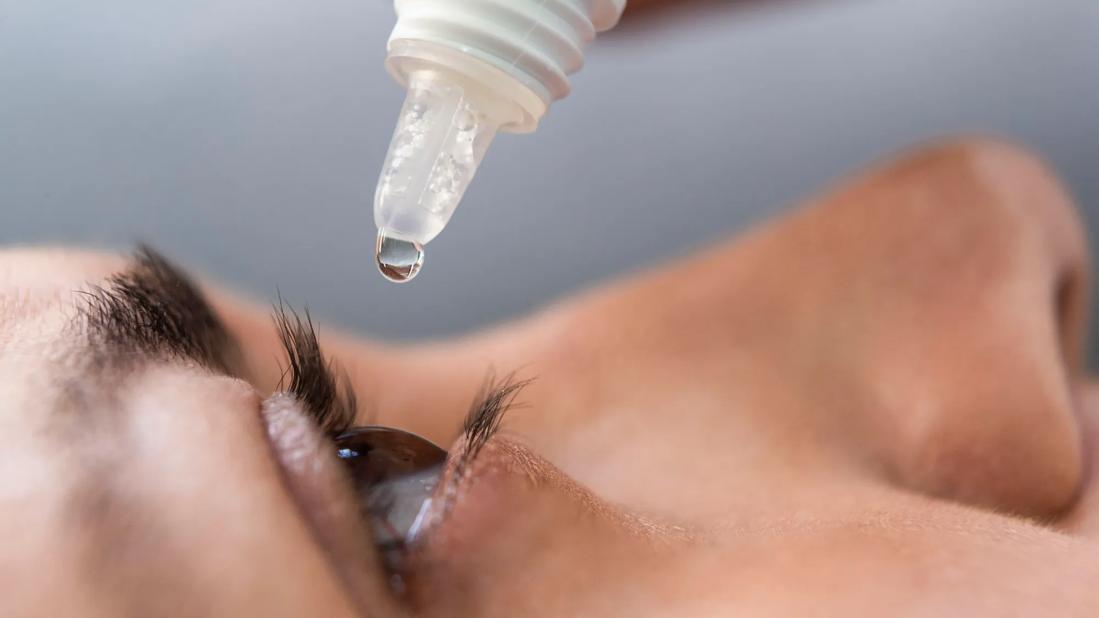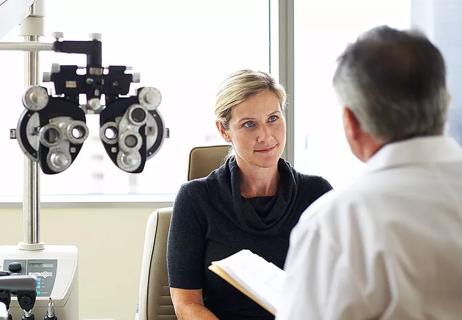The plain answer is ‘no’ — ingredients meant to clean and disinfect your contact lenses can cause irritation, redness or dryness to your eyes

Has this ever happened to you?
Advertisement
Cleveland Clinic is a non-profit academic medical center. Advertising on our site helps support our mission. We do not endorse non-Cleveland Clinic products or services. Policy
You’re wearing contact lenses and going about your day, when it feels like something’s stuck in your eye or your eyes begin to feel dry and irritated.
Using eye drops sounds like the perfect solution, right? Then, you realize you don’t have any handy, but you do have a bottle of contact solution. Hmm…
Can you use contact solution as eye drops?
Optometrist Reecha Kampani, OD, explains how contact solution and eye drops are made and why it isn’t a good idea to substitute them for each other.
While it may seem like the ingredients in contact solution and eye drops are the same, they’re not interchangeable. Bummer, we know.
You shouldn’t use contact solution (such as multipurpose contact solution or hydrogen peroxide-based solution) as eye drops (like artificial tears, rewetting drops and allergy eye drops).
Dr. Kampani points out that contact solution and eye drops are made with different ingredients intended to do different things.
Contact solution typically uses preservatives to help clean contact lenses of debris, dirt and a buildup of protein; while eye drops use a variety of ingredients to either moisturize or lubricate your eyes. In some cases, medicated eye drops may contain ingredients to help treat issues such as pink eye.
Advertisement
“Contact solution has ingredients in there that are meant to clean, disinfect and store contacts. They’re not formulated to be used as an eye drop,” states Dr. Kampani. “In fact, using contact solution as an eye drop may cause irritation if you put the solution directly into your eye.”
On the other hand, you’d like to take your contacts out and rinse them clean — but you don’t have any contact solution handy. Can you use eye drops in place of contact solution?
No, just as you shouldn’t use contact solution as eye drops, you don’t want to use eye drops as contact solution.
“There’s not going to be any ingredients in eye drops that are designed to clean your contacts,” clarifies Dr. Kampani. “You may end up moisturizing your eye and the lens, but you’re not going to be cleaning the contact. If the eye drops aren’t compatible for a contact lens — some drops have a milky consistency or oily consistency meant for specific types of dry eye — that may potentially degrade your contact lenses.”
There’s really no substitute for contact solution, as, again, it’s designed specifically to clean, disinfect and store your lenses.
Using contact solution as eye drops can’t be so bad, you may think. But Dr. Kampani says possible symptoms can include:
You may also experience damage to your cornea — and this can happen especially if you use a hydrogen peroxide-based solution as eye drops. If you use a hydrogen peroxide-based solution system, the solution starts out as hydrogen peroxide and then changes to a saline solution once stored in a special case with a neutralization disc.
“If the solution isn’t neutralized and you use it, you will burn your eye,” she warns. “You’ll have a good chemical burn. It will heal, but it will be very painful.”
In that case, you may want to use preservative-free artificial tears every hour. She adds that you could also use an over-the-counter lubricating ointment to help moisturize and heal your eye’s surface.
“If you’re having a lot of irritation, your eye doctor may prescribe medication to help with pain and help the area heal a little bit faster,” says Dr. Kampani. “This may include steroid eye drops if you’re having a lot of inflammation and irritation.”
By the way, you shouldn’t ever use water or your own saliva to clean a contact lens either — even in a pinch. (Trust us. We know from personal experience this isn’t a good idea. Plus, Dr. Kampani says it’s a big no-no.)
Advertisement
So, let’s recap: You cannot use contact solution as eye drops — never put contact solution directly into your eyes. And you cannot use eye drops as contact solution. Nor should you ever use water or spit (or any other liquid, including expired contact solution) to clean contact lenses.
If you do end up turning to an alternative way to clean your lenses or refresh your dry eyes, you should probably throw that pair of contact lenses away and start with a fresh pair.
“And if you notice any eye pain, eye discharge or redness when putting in your contacts, you should remove them immediately and contact your eye care doctor,” stresses Dr. Kampani.
Advertisement
Learn more about our editorial process.
Advertisement

Expect to be seeing clearly just 24 hours after LASIK surgery

Your eyes may sting or burn for a few hours after surgery — that’s why your surgeon will recommend a nap

The first three days can be tough — but easier days are ahead

PRK and LASIK are both laser eye surgeries that can help you see better, but they’re different in technique, recovery time and who can benefit

Both procedures are about equally effective, but which is better depends on your vision needs and current conditions

It usually takes anywhere from a couple of days to a few weeks to get fully adjusted

When worn incorrectly, contacts can cause or worsen dry eye symptoms

The lifespan of contact lenses depends on whether you have reusable or disposable lenses

Babies can get congested easily, but you can calm their cough by keeping them hydrated, using nasal drops and running a humidifier

Weight loss may cause loose, sagging skin and muscle loss to your rear

Several conditions, like vitiligo and fungal infection, can cause a loss of pigmentation, leading to white spots or patches on your skin